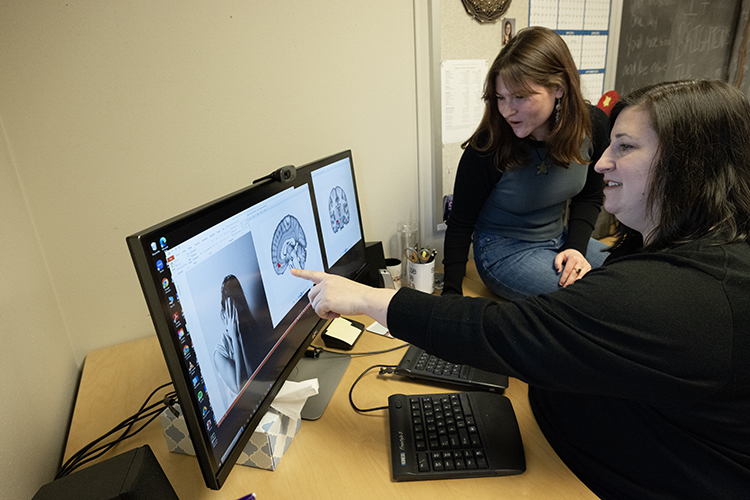When people experience a traumatic event, such as injury in a car accident or physical violence, most will rebound with no adverse long-term consequences. For others, the trauma sets off symptoms of post-traumatic stress disorder that may last for years.
UWM neuroscientist Christine Larson wondered why the effects of trauma vary so much – and whether it’s possible to predict who is most likely to develop severe or chronic PTSD. If intervention were given to the vulnerable sooner, it could ease their symptoms or maybe even stave them off entirely, said Larson, a professor of psychology.
Larson believes the key can be found in brains scans.
She has partnered with two health professionals on three different studies involving brain imaging of patients who show up at the hospital emergency department after suffering a traumatic event that causes injury. Together the projects are supported by more than $11 million in grants from the National Institutes of Health.
The information emerging from the studies is stimulating new questions about who does and does not rebound after trauma – and why.
An initial study with adults
The brain scanning technique used in the research, called functional magnetic resonance imaging, or fMRI, show areas of the brain that are active while the person is thinking purposefully, such as contemplating a task, and also when the person is relaxing. FMRI scans look different if people are remembering fear and anxiety, compared to something that isn’t emotional. So, scientists can compare these.
Larson and her collaborations at the Medical College of Wisconsin look at two specific brain regions: the amygdala, which is involved in processing fear and other negative emotions caused by trauma, and the prefrontal cortex, which helps regulate the amygdala.
During the scanning, Larson asked participants to recall the event that brought them to the emergency department. For comparison, they also scanned the patients completing a task unrelated to their trauma.
The timing of the scans makes Larson and her partners’ study unique.
Most of the existing data that scientists have come from brain scans of people who’ve been experiencing PTSD for a long time. By itself, that data doesn’t reveal how the brain might process trauma differently, said Larson. She found that comparing brain scans taken soon after the trauma occurred with ones taken later is revealing how PTSD unfolds.
So Larson and Terri deRoon-Cassini, a health psychologist and professor at the Medical College, set out to image the brains of 200 adult patients within two weeks of their injury.
The results with adults showed evidence that some people are “set up” for PTSD following a trauma. Once their brain’s fear-processing center was activated, more vulnerable patients had trouble “learning” when the threat had passed and that they were safe again.
Their scans showed exaggerated activation in the amygdala, and weak regulation from the prefrontal cortex.In those who don’t develop PTSD after trauma, both brain regions are doing their jobs effectively.
Current study with children
The next stage of Larson’s study is underway – the ability to predict a severe PTSD outcome with children. Larson and Dr. Michael Levas, a pediatric physician in emergency medicine at Children’s Wisconsin, are recruiting 200 kids between ages 10 and 17 who have been treated at the emergency department after injury.
The researchers are scanning their young patients’ brains soon after those visits and collecting other kinds of data, such as stress hormones, along with surveys that measure other aspects of a child’s life that might affect how they recover from a trauma.
The question is, “Can the data collected two weeks after trauma help predict who’s most likely to have PTSD or depression a year later?”
“Youth are very understudied,” Larson said. “No other study like this one has been done with children.”
Addressing the problem requires a better understanding of the trajectory of resilience in children, Levas said. Studies like this one provide an opportunity to learn what trauma does to the developing brain.
“The human brain is not generally thought to be fully mature until the early 20s, so it makes sense that children might have maladapted stress responses or might not be able to process their trauma,” he said. “What is interesting to me would be if there are any novel regions in the developing brain that show either increased or decreased activity in comparison to adults.”
More study of trauma in kids is vital because of the large number of youths who suffer gun violence.
“More kids in the U.S., including Milwaukee, die from firearms than any other disease process,” said Levas, who also leads Project Ujima, a program at Children’s that provides emotional and social support for youth victims of violence who come to the emergency department.
When trauma never lets up
The results of these studies also will help Larson and her partners unlock the effects of sustained or chronic trauma, including living in poverty, constant exposure to violence, and racial or sexual discrimination. That is the subject of her forthcoming research project.
“The brain doesn’t operate in a bubble,” she said. “It’s not just about what’s happening in the brain, but what that brain is exposed to in terms of peer relationships, family relationships and neighborhood-level variables like resource disadvantage.”
These conditions cause the body to remain in a state of hypervigilance, she said. “Some people tell me they are never able to truly relax. And that sustained trauma is reflected in the brain data we see.”
There’s reason for hope, however. Receiving cognitive or behavioral interventions does help people with chronic PTSD, she said.
MCW’s deRoon-Cassini found that the severity of the traumatic incident is not as important as the victim’s own perception of how traumatic it was. That means it’s possible to teach a person experiencing PTSD to reframe how they’re perceiving the trauma and regulate their emotions better.
The effects of that therapy also can be seen on their brain scans. Ultimately, she added, these studies are important in understanding the brain’s ability to recover.
But can early intervention keep PTSD from occurring at all?
“The data is so minimal that we don’t know yet,” she said. “There is evidence that it can definitely minimize PTSD symptoms, but can we completely prevent it? We just need more research on that.”







